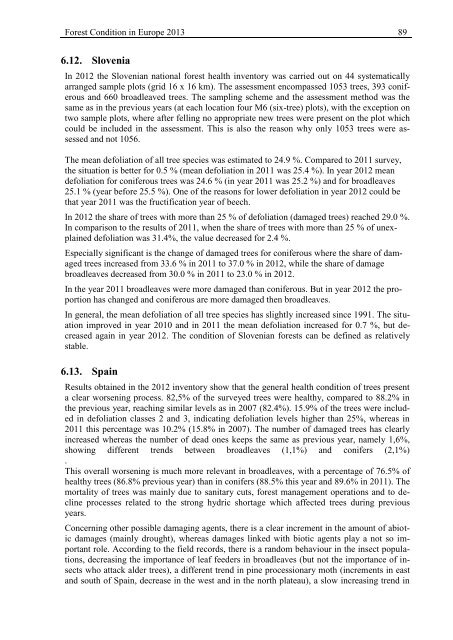Forest Condition in Europe - ICP Forests
Forest Condition in Europe - ICP Forests
Forest Condition in Europe - ICP Forests
Create successful ePaper yourself
Turn your PDF publications into a flip-book with our unique Google optimized e-Paper software.
<strong>Forest</strong> <strong>Condition</strong> <strong>in</strong> <strong>Europe</strong> 2013 89<br />
6.12. Slovenia<br />
In 2012 the Slovenian national forest health <strong>in</strong>ventory was carried out on 44 systematically<br />
arranged sample plots (grid 16 x 16 km). The assessment encompassed 1053 trees, 393 coniferous<br />
and 660 broadleaved trees. The sampl<strong>in</strong>g scheme and the assessment method was the<br />
same as <strong>in</strong> the previous years (at each location four M6 (six-tree) plots), with the exception on<br />
two sample plots, where after fell<strong>in</strong>g no appropriate new trees were present on the plot which<br />
could be <strong>in</strong>cluded <strong>in</strong> the assessment. This is also the reason why only 1053 trees were assessed<br />
and not 1056.<br />
The mean defoliation of all tree species was estimated to 24.9 %. Compared to 2011 survey,<br />
the situation is better for 0.5 % (mean defoliation <strong>in</strong> 2011 was 25.4 %). In year 2012 mean<br />
defoliation for coniferous trees was 24.6 % (<strong>in</strong> year 2011 was 25.2 %) and for broadleaves<br />
25.1 % (year before 25.5 %). One of the reasons for lower defoliation <strong>in</strong> year 2012 could be<br />
that year 2011 was the fructification year of beech.<br />
In 2012 the share of trees with more than 25 % of defoliation (damaged trees) reached 29.0 %.<br />
In comparison to the results of 2011, when the share of trees with more than 25 % of unexpla<strong>in</strong>ed<br />
defoliation was 31.4%, the value decreased for 2.4 %.<br />
Especially significant is the change of damaged trees for coniferous where the share of damaged<br />
trees <strong>in</strong>creased from 33.6 % <strong>in</strong> 2011 to 37.0 % <strong>in</strong> 2012, while the share of damage<br />
broadleaves decreased from 30.0 % <strong>in</strong> 2011 to 23.0 % <strong>in</strong> 2012.<br />
In the year 2011 broadleaves were more damaged than coniferous. But <strong>in</strong> year 2012 the proportion<br />
has changed and coniferous are more damaged then broadleaves.<br />
In general, the mean defoliation of all tree species has slightly <strong>in</strong>creased s<strong>in</strong>ce 1991. The situation<br />
improved <strong>in</strong> year 2010 and <strong>in</strong> 2011 the mean defoliation <strong>in</strong>creased for 0.7 %, but decreased<br />
aga<strong>in</strong> <strong>in</strong> year 2012. The condition of Slovenian forests can be def<strong>in</strong>ed as relatively<br />
stable.<br />
6.13. Spa<strong>in</strong><br />
Results obta<strong>in</strong>ed <strong>in</strong> the 2012 <strong>in</strong>ventory show that the general health condition of trees present<br />
a clear worsen<strong>in</strong>g process. 82,5% of the surveyed trees were healthy, compared to 88.2% <strong>in</strong><br />
the previous year, reach<strong>in</strong>g similar levels as <strong>in</strong> 2007 (82.4%). 15.9% of the trees were <strong>in</strong>cluded<br />
<strong>in</strong> defoliation classes 2 and 3, <strong>in</strong>dicat<strong>in</strong>g defoliation levels higher than 25%, whereas <strong>in</strong><br />
2011 this percentage was 10.2% (15.8% <strong>in</strong> 2007). The number of damaged trees has clearly<br />
<strong>in</strong>creased whereas the number of dead ones keeps the same as previous year, namely 1,6%,<br />
show<strong>in</strong>g different trends between broadleaves (1,1%) and conifers (2,1%)<br />
.<br />
This overall worsen<strong>in</strong>g is much more relevant <strong>in</strong> broadleaves, with a percentage of 76.5% of<br />
healthy trees (86.8% previous year) than <strong>in</strong> conifers (88.5% this year and 89.6% <strong>in</strong> 2011). The<br />
mortality of trees was ma<strong>in</strong>ly due to sanitary cuts, forest management operations and to decl<strong>in</strong>e<br />
processes related to the strong hydric shortage which affected trees dur<strong>in</strong>g previous<br />
years.<br />
Concern<strong>in</strong>g other possible damag<strong>in</strong>g agents, there is a clear <strong>in</strong>crement <strong>in</strong> the amount of abiotic<br />
damages (ma<strong>in</strong>ly drought), whereas damages l<strong>in</strong>ked with biotic agents play a not so important<br />
role. Accord<strong>in</strong>g to the field records, there is a random behaviour <strong>in</strong> the <strong>in</strong>sect populations,<br />
decreas<strong>in</strong>g the importance of leaf feeders <strong>in</strong> broadleaves (but not the importance of <strong>in</strong>sects<br />
who attack alder trees), a different trend <strong>in</strong> p<strong>in</strong>e processionary moth (<strong>in</strong>crements <strong>in</strong> east<br />
and south of Spa<strong>in</strong>, decrease <strong>in</strong> the west and <strong>in</strong> the north plateau), a slow <strong>in</strong>creas<strong>in</strong>g trend <strong>in</strong>
















